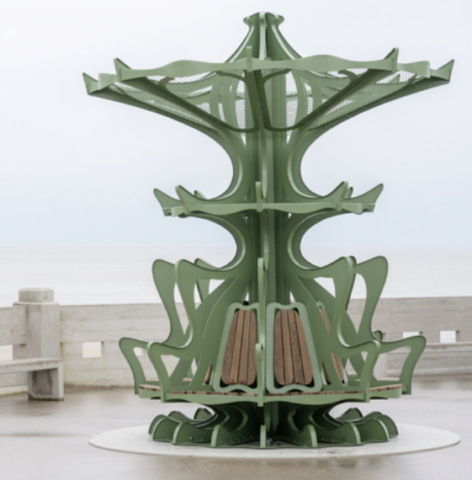Revamp: Album Art, Aestheticizing Music
By Jo Phillips
In the wake of the publication of Vinyl. Album. Cover. Art, we’re reconsidering the legacy, importance and status of album artwork.

Led Zeppelin, Houses of the Holy
1973
Photography: A. Powell
Hand tinting: P. Crennell
© Mythgem Ltd
“This is a RECORD COVER. This writing is the DESIGN upon the record cover. The DESIGN is to help SELL the record cover…” – so begins the cover of XTC’s 1978 album ‘Go 2’. It’s a tongue in cheek design by legendary art collective Hipgnosis, considering the role of album artwork. It does, however, tap into a truth. The first album artwork was designed in 1938 by Alex Steinweiss and, at the time, Newsweek reported that sales of Bruno Walter’s Beethoven’s Eroica symphony went up 895% over the unillustrated copy. Great album artwork is like the opening sequence of a film, or the first line of a book: it provokes us, it asks questions but doesn’t give us answers. It sets up the mood of the music, giving us a visual reference, opening our imagination, letting us imagine the sounds in devilish anticipation.
![48_Syd_Barrett_The_Madcap_Laughs_inner_gatefold[1]_opt](https://i0.wp.com/centmagazine.co.uk/wp-content/uploads/2017/05/48_Syd_Barrett_The_Madcap_Laughs_inner_gatefold1_opt.jpg?resize=580%2C288)
Syd Barrett, The Madcap Laughs
1970
Photography: S. Thorgerson
© 2017 Hipgnosis Ltd
It’s the seductive build up – it dampens our appetite and quickens our pulse (I’m thinking of the opening sequence of Gaspar Noe’s ‘Enter the Void’). It gives us that tantalizing sip of what’s to come, without providing us with any real answers, and often leading us into dead-end streets.

10cc, Deceptive Bends
1977
Photography: A. Powell/S. Thorgerson/P. Christopherson
Graphics: G. Hardie
Retouching: R. Manning
© 2017 Hipgnosis Ltd
Rather than just being a sales tool devoid of artistry, cult filmmaker Panos Cosmatos speaks of the influence that film covers and artwork had on him. As a young kid, he spent hours in video stores looking at covers of films he was too young to watch. In his mind, he would form images and narratives of the movies solely based on their artwork. This was the starting point and inspiration for his film ‘Beyond the Black Rainbow’. This anecdote illustrates exactly why album artwork and visualization is important even today, in the age of online music streaming: the artwork adds a whole new category of experience to the music – it is a visual reference for the sound. Who can’t help picture that refracted prism when they listen to Pink Floyd’s Dark Side of the Moon?
![122_Pink_Floyd_Dark_Side_of_the_Moon[1]_opt](https://i0.wp.com/centmagazine.co.uk/wp-content/uploads/2017/05/122_Pink_Floyd_Dark_Side_of_the_Moon1_opt.jpg?resize=580%2C285)
Pink Floyd, The Dark Side of the Moon
1973
Graphics: G. Hardie
© Pink Floyd Music Ltd
Since 1959 there has been a Grammy award for Best Recording Package, but often they haven’t chosen the best work. In fact, looking at the list of winners, one could be persuaded that record artwork is a lesser art form. However, other more recent awards have awarded more innovative and exciting artwork, such as ‘The Best Art Vinyl Award’, which has a travelling exhibition of the 50 shortlisted works (thus elevating the art form).
![203_Pink_Floyd_Animals[1]_opt](https://i0.wp.com/centmagazine.co.uk/wp-content/uploads/2017/05/203_Pink_Floyd_Animals1_opt.jpg?resize=580%2C438)
Pink Floyd, Animals
1977
Cover design: R. Waters
Photography: A. Powell with H. Bartrop
Additional photography: P. Christopherson, N. Tucker
© 2017 Pink Floyd Music Ltd
In the digital age, the move away from the concrete album does threaten album artwork, and it’s for this reason that Vinyl. Album. Cover. Art is so timely. The book, from Thames & Hudson, contains the complete collection of the legendary Hipgnosis design collective. Founded in 1967 by Strom Thorgerson and Aubrey Powell, the artists transformed the category of album art forever. They revolutionized design by moving away from conventional group shots of the musicians and towards a ground-breaking surreal aesthetic. This book charts the story, context and inspiration of the design collective responsible for creating the aesthetic for some of the most important names of the century, including AC/DC, Black Sabbath, The Police, Led Zeppelin, Pink Floyd, Bad Company, Yes and XTC. Anyone who has an interest in music, art or visual culture should pick up a copy of the book, if just to have a leisurely flick through the sublime, remastered pictures.
It would, however, be a mistake to stop there. In the history of art there’s been a long lineage of artists inspired by music – Basquiat’s work can be viewed as pictorial jazz music and Kandinsky wanted to create the visual equivalent of a symphony (our favourite examples). But, there’s a less talked about path that some artists explore.

Artwork Courtesy of Dougal McKenzie
Scottish artist and John Moores Painting Prize winner Dougal McKenzie has experimented with record covers. Some of McKenzie’s first work as a teenager was inspired by looking at record covers, and since then it has become a recurring source of inspiration. By his own admission, the works were sometimes the result of having no other ideas for paintings. His ongoing 2014 series ‘It’s All Over for Us Now’ is a return to working with record covers. He often plays the records in the background while making his paintings, creating a more abstract and tenuous link to the music than we see in mainstream album art. In such a way, he annexes the music for his own aims, inverting the roles. Rather than the artwork accompanying the music, the music accompanies the artwork – its role now subservient and residual.
The place and influence of album artwork has obvious pictorial relevance throughout a lot of McKenzie’s work. Certain motifs and tropes reverberate, sparking memories of ideas.
New work by the artist will be on display at the MAC, Belfast, from June 29.



![The [Alternative] Animal-Themed-Band-name Guide](https://centmagazine.co.uk/wp-content/uploads/2017/04/echo-and-the-bunny-men-_opt_opt.jpg)


